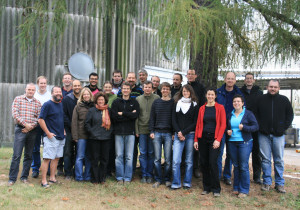APPRAISE-CLOUDS Project - Laboratory Measurements

Laboratory ice nucleation experiments as part of the APPRAISE-CLOUDS project were carried out at the AIDA chamber in Karlsruhe, Germany during October 2009 as part of an international project with participants from Germany, Switzerland, the UK and the USA. The AIDA facility consists of a large stainless steel vessel installed in a freezer which can be operated as an expansion cloud chamber. Additionally there is a second smaller chamber which is used for aerosol aging and characterisation. A more detailed description of the AIDA facility can be found on the AIDA website.
The objective of the experiments carried out was to investigate the effectiveness of different types of atmospherically relevant ice nuclei over a range of temperatures and supersaturations. Potential ice nuclei investigated included several types of desert dust, and soot, with and without secondary organic coatings. Experiments were also conducted with ambient aerosol. Ice nucleation properties were investigated at temperatures ranging from -40 to -10 and at supersaturations from just above ice saturation to well above water saturation, thus investigating different ice nucleation mechanisms and being representative of a wide range of atmospheric cloud types.
For a typical experiment aerosol would first be injected into the AIDA chamber which has been humidified to close to ice saturation at the temperature of operation. This aerosol would consist of either dust or soot (or a mixture of both) directly injected into the AIDA, or would be aerosol transfered from the second chamber which had been coated with secondary organic material. Aerosol in the chamber would then be characterised with a range of instrumentation before the cloud experiment started. Measurements were made of aerosol size distribution, chemical composition, and cloud condensation and ice nuclei number. Once aerosol sampling was completed, sample flow to the cloud physics instruments would be started and air would be pumped from the chamber producing a near adiabatic expansion. This type of expansion causes the temperature in the chamber to drop and the air to become superaturated. Thus a cloud forms on available aerosol. As the expansion continues the supersaturation continues to rise until there are sufficient cloud particles that vapour competition reduces the supersaturation. During this time the cloud physics instruments sample the cloud in the chamber determining particle number, phase (liquid or ice) and crystal habit as a function of temperature and supersaturation.
During these experiments the Centre for Atmospheric Science supplied and operated the 2DS instrument (ice particle number concentration and habit) and the WIBS instrument (bioaerosols). The WIBS only sampled from the chamber during ambient aerosol experiments, for the rest of the period ambient air was sampled from outside the laboratory. The CAS ice nucleus counter was also shipped to AIDA for these experiments, but was damaged in transit so could not be operated.